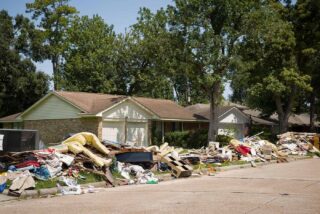
Hurricane season, which extends through the end of November, has already brought great devastation to Gulf and East Coast states, while wildfires are sending ash and toxins into the air as they blaze throughout the Western U.S. As these areas continue their road to recovery with large cleanup efforts, they may be facing other unseen dangers brought to the surface from these storms: toxins like asbestos.
Because of its wide and varied past, asbestos can be found in thousands of old buildings, homes, and schools. In the event of natural disasters bringing structural damage, or even demolishing such buildings, the asbestos-containing materials may release dangerous fibers into the air. Residents and first responders may be the most at risk of exposure, though the fibers can remain in the air for long periods of time.
It’s important to know how to help protect yourself and your loved ones from possible exposure after these events and throughout the cleanup efforts. Taking the proper precautions can prevent a future diagnosis with an asbestos-related disease.
Asbestos Regulations After Natural Disasters
While asbestos isn’t banned, there are many federal regulations to limit its use and help protect both workers and citizens from exposure. For the most part, all of these regulations continue to be upheld even in the aftermath of a natural disaster.
The EPA realizes it can be difficult to adhere to every aspect of the law, as these communities may face a lack of experienced personnel available to handle the cleanup, limited space in landfills for asbestos-containing materials, and the desire to handle the cleanup and any demolitions and renovations as quickly as possible after the storm. As such, in certain situations, building owners and crews may receive some leeway in regard to a few of the outlined requirements.
In general, building owners are still required to adhere to the majority of the regulations in place under the EPA’s Asbestos NESHAP and the Asbestos Hazard Emergency Response Act (AHERA). For such renovation or demolition projects to be allowed flexibility with regulations, they must meet the definition of an emergency renovation, which the EPA defines as a sudden, unexpected event that requires such work, and there must be a certain amount of asbestos-containing materials present at the site.
At normal times, the rules under NESHAP state the local air quality board or governing body for that state must be notified of demolitions or renovations involving asbestos materials at least 10 working days prior to a project’s start. In cases of emergencies like a natural disaster, they understand the desire to begin such projects as quickly as possible to get a community back to normal, so the requirement is changed to a notification at least the day after emergency work begins.
The EPA maintains that at least one asbestos professional should be on site to ensure the proper handling and disposal of asbestos, including properly wetting the materials to avoid friable fibers and sealing waste in labeled containers. The only change in handling the asbestos may come in where the waste can be disposed of. With many emergency renovations, certified landfills in the area may not be able to handle the amount of asbestos waste coming in. Still following the proper procedures, the asbestos can sometimes be taken out of state or a state can relax some requirements as they see fit to handle the waste.
How to Protect Yourself from Exposure
Even with the regulations upheld to help protect workers and residents, many are still at risk of accidental asbestos exposure. For one, it can be hard to determine how much, if any, asbestos materials have been damaged by a storm. Thousands of older homes and buildings, including schools, built prior to 1980 are assumed to contain the mineral somewhere in their construction, but in the aftermath of a storm, determining the age of a building isn’t at the top of the to-do list.
Asbestos in general isn’t easy to identify just by looking at the material or product. It can be difficult to tell what debris or remains from a building might contain the toxin without a professional’s help. As such, it’s extremely important to not disturb any materials or construction debris you come across in case any present asbestos fibers become airborne.
Though asbestos should be handled by a professional, if you are helping with cleanup or other home projects after a storm and can assume asbestos may be present, it’s important to follow the guidelines in place from the EPA. Ensure everyone working knows to properly wet the materials being removed in case of any hidden asbestos, and keep all of these waste materials contained in a leak-proof, sealed bag to prevent any spilling or escape of the mineral.
Experts also recommend taking further precaution while working in these areas with protective gear. People should wear clothing so they are fully covered, from pants and shirts to gloves and goggles. Even more importantly, it’s recommended to wear a tightly-fitted approved respirator that can filter out dangerous substances. An average mask for dust will not be suitable protection from asbestos fibers or other toxins in the air. Ensuring the mask fits properly is also extremely important, or exposure can still potentially occur.
In addition to wearing these protective garments, it’s also important to keep in mind toxic materials that may stick to the clothing you wear. In the past, many families and loved ones of workers in so many industries like construction were exposed to asbestos because the worker unknowingly brought fibers home on their clothes and in their hair. Changing your clothes and properly containing them to be discarded after helping in such dangerous areas can help prevent exposure.
There are, of course, many worries during a natural disaster and the following cleanup. But being aware of asbestos and taking the appropriate measures to protect yourself and loved ones can prevent facing a rather grim diagnosis in the future.




